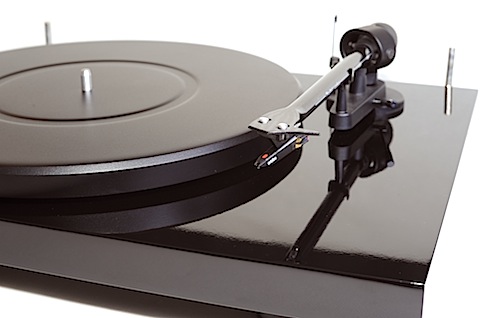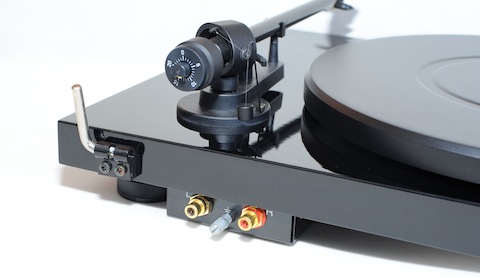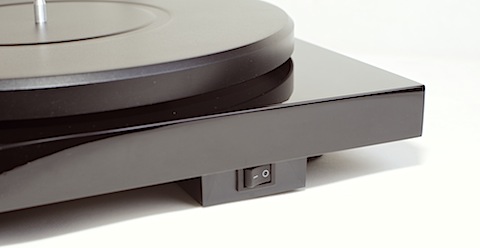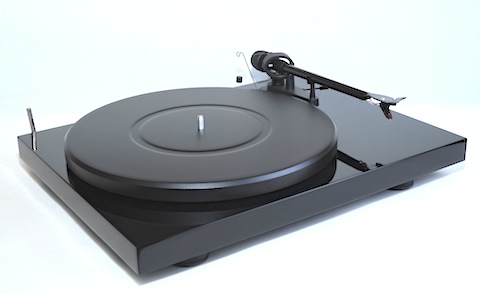PRO-JECT AUDIO SYSTEMS DEBUT CARBON turntable
Rating: 




First impressions: A carbon fibre tonearm on an entry-level turntable? It’s true folks, we’ve got it here with Pro-ject Audio Systems’ Debut Carbon turntable, the company’s fourth generation offering to wear the “Debut” moniker.
To many, this would’ve seemed a, uh, pipe dream some time ago. I remember the first Wilson-Benesch turntable package, the apparent justification for its not unsubstantial price being liberal use of this material, most obvious visually in its tonearm shaft.
I’m also from the generation to whom carbon-reinforced tennis racquets were first marketed (well, they were called “graphite”, but to us non-materials engineers, it’s about the same thing) and had drooled over the Donnay racquet used by Bjorn Borg in the early 1980s, thinking I would never ever be able to afford something like it in my lifetime.

So yeah, I suppose you could say I’ve been conditioned to think carbon fibre must be an expensive exotic space-age material that has little relation to the stuff in the pencils we used to write with (remember those?). But things have changed quite a bit since then.
Carbon-graphite tennis racquets are now easily affordable, and old hat to the point manufacturers need to incorporate ever more exotic sounding materials like boron, titanium, Kevlar, or what-have-you to catch one’s eye, and carbon-graphite badminton racquets are available even at near penny-level prices. So, some may see this as a price-breakthrough offering, others a “huh, it’s about time” non-event.

Specs: The carbon fibre tonearm from which the Debut Carbon (just Debut from now on) derives its name apart, the entire package is a two-speed (33.33 and 45 rpm) belt-driven manual turntable. Drive comes from a small AC motor topped with a metal stepped pulley of different circumferences which the user has to manually adjust the belt on, for speed selection.
There is an electronic speed switching upgrade option available from the manufacturer but this was not included with the review sample.
The Debut has a wood-derivative plinth and the entire table’s overall size is 118 x 415 x 320mm (h/w/d), coming in a variety of attractive high gloss finishes (shiny black on the review sample – looks fab, but calls out to be dusted every other minute).
The Debut now gets a nicely weighted full-sized pressed metal platter, bigger than the one from the previous generation, where the lead-in grooves of an LP would hang overboard as its circumference was larger than the platter’s, and a solid acrylic dust cover which feels a lot more substantial than that of its obvious rival’s (need I say who?) thinned-out offering.
Other improvements include a new screwed-down damped mounting pad scheme for the motor (I think it may have been offered as an upgrade with the previous generation) and it is with this that the adage “there’s as much misinformation as there is information on the internet” becomes relevant.
There are several videos posted on YouTube on how to set up this latest Debut, not all by parties necessarily endorsed by the manufacturer, one anomalous one advising removal of the screws coupling the motor to the vibration dampening pads where the motor interfaces with the plinth. Don’t do this, folks! Read the manufacturer’s instruction manual and ignore what owners of the previous generation Debuts tell you.

Actually, the instructions are silent on this aspect, which may actually be a contributing reason leading to this confusion. Specialist hi-fi equipment retailers are arguably the most hardcore of the “real men don’t read manuals” practitioners (and almost all are men), and I can imagine a few may have just assumed what applied with the previous version surely must be being perpetuated with this one.
Other than this, I do admit if you’re a newbie to the world of turntables, it’s a lot easier to be instructed on how to set up the Debut from a two minute video than spend the effort reading instructions on a few sheets of A4-sized paper.
If there is a disappointing aspect to the Debut, for me it would be the mat that is provided to support the record on the platter. Though it really is no worse than the one provided in the rival manufacturer’s counterpart offering, and that it sticks to the bottom of the LP during side changes due to static is not unexpected, I found that sonic performance improved noticeably when the mat from a Linn LP12 was used in its place.
For the review, the stock mat was used, though, but little details like these are indicative of there being latent performance potential waiting to break out from the confines the basic package Debut finds itself facing due to economic realities its manufacturer has to face in bringing such a product to the market at its targeted price.
As for the power on/off switch, this is now located somewhere toward the middle depth-wise on the left side of the plinth. I raise this because even though you may have enough top clearance to change LPs in the mid-tiers of your equipment rack to want to place the Debut there, if the sides of the rack are closed up or otherwise inaccessible, you may not be able to work the Power switch, compared to say, if it had been somewhere along on the bottom front of the plinth, which I think it was for the previous version (actually, I don’t recall exactly where the last version’s was, but its location did vary across the previous iterations… I think).
In use, there were no anomalies that would cause one to opine adversely against this turntable’s mechanical aspects. The motor started, ran and stopped with no overt noises and it had quite healthy torque on it, the platter still spinning gamely when I ran a carbon fibre brush across LPs laid on it during pre-play dusting. The belt (flat on this version) ran true without any up and down movements on the light polymer sub-platter.
The tonearm’s stiffer-than-thou carbon shaft notwithstanding, overall, the bearings did not feel particularly silky and I would argue that those in the competition’s offering are slightly more confidence-inspiring. The packaged cartridge is the evergreen Ortofon OM10, and the tonearm cable is detachable, the internal cable terminating at the back of the Debut in a junction box sporting the left and right RCA connectors with a ground cable lug.

Performance: Whether it is the carbon shaft tonearm, the new mounting regime for the motor, the bigger heavier platter or the engineers at Pro-Ject just refining little other things that didn’t get trumped up in the product promotional literature, one cannot fail to be impressed with the overall performance of the new Debut. From the very first record heard in serious listening and evaluation, the Debut easily ticked all the required boxes for gaining “Recommended” status.
The first record (and those which followed) was “enjoyed” as much as it was “listened to during evaluation”, the tonal clarity of the sustained strings on Johann Sebastian Bach’s Air on the G String sounding confident, with the Debut combination easily keeping stable pitch and allowing the separate portions of various string instruments to sound distinctive, yet stay part of the overall musical whole.
Piano tracks played by the late Van Cliburn were also well reproduced, with quick transients and sustained notes stably presented with no obvious wavering when fading out.
I found that groove noise, and pops and clicks were not prominent, showing the combination’s ability to play through challenges in software condition, being the sign of a well-sorted turntable combination. Images had clear focus with good image outline delineation, which in comparative listening could sound softer and less defined on a Rega P1 combination (with an Ortofon OM5 and stock MDF platter and mat).
The perspective offered by the Debut-Ortofon OM10 was one of fairly good width and competent depth (a better cartridge is warranted) and any limitations on the amount of air and treble smoothness emanating from the combination could probably be put down to the limitation in the cartridge’s performance.

Cellos and double basses were weighty and well proportioned, doing a very good job for a turntable in this class. By comparison, the Rega P1 sounded that bit thinner bottom-wise, suggesting a few of the cellists and bass players had gone off for a toilet break in the middle of the performance.
The flute pyrotechnics of James Galway playing Rodrigo’s Concerto Pastoral for Flute (1st Movement), which can tip over into relentlessness on a poor turntable, was reproduced with aplomb save in several places where there was hint of tracking distortion on the Debut-OM10 combi (but which stayed clean on a Garrard 401-RB300-Rega Exact, another combination used as reference). The Galway LP gave the Rega P1 a rather much harder time than it did the Debut, though.
On rock tracks, there was little to complain about, Meg White’s drums and cymbals on The White Stripes’ Seven Nation Army could perhaps sound weightier and more impactful (it did on the Garrard combination), but the frantic engagement factor was pretty much near-wholly preserved.
I had binged on quite a few LPs from the dealers who had set up stalls at the recent KL International AV Festival 2013, but one LP, and track I found myself playing repeatedly from the pile bought was the cover of Billie Holiday’s Don’t Explain by Joe Bonamassa and Beth Hart and to be honest, apart from little differences when the backing string section was clearly more realistic sounding on the more expensive turntables that I had with me, there seemed very little to choose between the Pro-Ject Debut Carbon and the higher ticket tables.
If one had auditioned just this track alone, an argument could be made for there not being much reason to put cash down for any of the more expensive tables.

The good: A strong showing in the sonic performance stakes, ease of initial set up by the new owner well thought out by the manufacturer, good looks (from the photographs I’ve seen, I rather fancy the gloss green one), space age materials in the tonearm, nice weighty metal platter, which would’ve been standard when the Thorens 150 and AR XA turntables were par for the course but is only too rare now, so what’s there not to like?
The ungood: One has to ask why the version sold in Europe and some other parts of the world gets the better… well, newer at least, Ortofon 2M Red, as part of the package? There were also quite a few occasions in use where I was “stung” by static electricity when handling the headshell of the carbon fibre arm.
I did feel the Rega P1’s feet did a better job of isolating it from the surface it stood on than the Debut’s – to minimise problems, most of the listening was done with the Debut sitting on a Mission Isoplat-Townshend CD Sink combi (the Mission at the bottom). You should pay a bit of attention to how/where the Debut is placed for performance optimisation.
Final verdict: The Debut Carbon is a keenly priced, attractively presented, musically satisfying turntable package, which still has sonic potential unrealised in its most basic form.
A better mat, better cartridge and the manufacturer’s power supply upgrade are all worth investigating but even the basic package gives such a strong showing so as to persuade one that it should be the choice to be given the allotted space on one’s equipment rack if one were shopping for a turntable in this price class.
Gear
Sources: Roksan Xerxes (early original, with DIY transformer power supply a la Naim Armageddon)-Rega RB1000-Linn K18II, Garrard 401 (with Bastin bearing)-Rega RB300-Rega Exact, Rega P1-Ortofon OM5, Pioneer PL-1200-Audio Technica AT91E / Amps: Parasound Halo JC3, ADL GT40 and Pro-Ject Tube Box DS phono stages, Euphonic Research ATT600 passive controller and silver-rodded Euphonic Research Amp-80 and Mesa Boogie Baron amplifiers / Loudspeakers: Sonus faber Guarneris, Apogee Centaurus Minor / Wires: Euphonic Research Dendrites, Axons, Wirewold Oasis interconnects (for comparison with the Debut’s stock external phono cable), Symo LS-5SX and some diy stuff.
Price: €299
Malaysian price: RM1,599
Malaysian distributor: Tong Lee Company (+603-2141 4366) / Find your distributor.
Lim Juan got into hi-fi for the same reason a good many (but not all) of us did – the love of music. He grew up on gear his dad had. His mother used to work in a record shop where dad bought his LPs, so the seeds of addiction were set before he was even born! He is now somewhat past the stage where high-end audio’s big brand names and fancy casework cause him to drool (though not completely out of it!). He has two children, one plays the cello, the other the violin, and he attends MPO concerts at the Dewan Philharmonic ‘somewhat regularly’.




